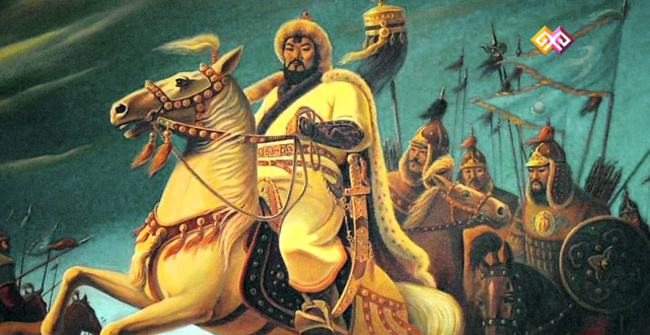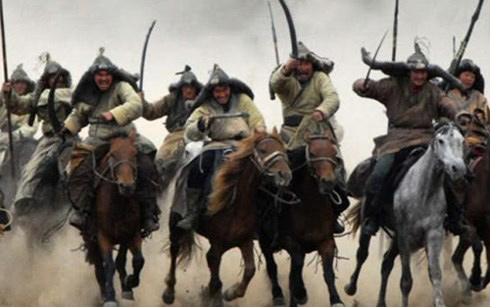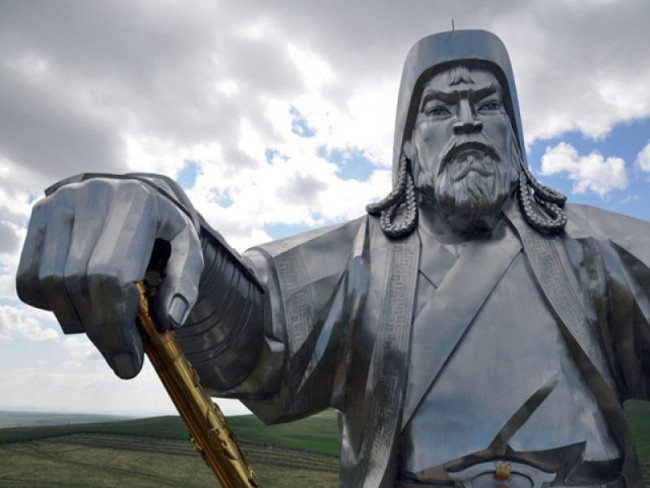10 little things to know about the notorious Mongol leader Genghis Khan
Genghis Khan is the founder of the immense Mongolian empire. He is an eminent leader, one that is known to the whole world but his life has many mysteries yet answers. Learn about the unexpected facts about this talented but notorious brutal Mongols.

The life of Thanh Cat Tu Han Khan has not many hidden corners still a mystery - (Photo: Internet).
Genghis Khan has "set a record" to conquer nearly 31 million square kilometers in his life. On that journey to conquer, he cut a brutal road through Asia and Europe, causing tens of millions of people to die. He unified the tribes and brought peace and peace to life throughout more than 5000 miles of trade roads, opening up the development of trade, tourism, cultural and religious exchanges between the East and the West.
1. The origin of the name of Genghis Khan
He was named Jupiter, after the very brave leader of a Tatar tribe who was defeated by his father.
Genghis Khan was born around 1162 and died in 1227, being a member of the SciEve family and the eldest son of Cui Cai Cai, a leader of the Khất Nhan tribe.
In 1206 the Moc Chan Foundation successfully linked the Mongol tribes that were divided and at the conference (the council of Mongol leaders) he was conferred the Genghis Khan (in Mongolian as the king of the whole). world).
The term Khan (Khan) is a traditional title used to refer to "leader" or "ruler". As for the name "Thanh Cat Tu" (Genghis), the historians are still unknown. This word can mean "ocean" or "righteous." In the context of this character, this word is often translated into "supreme ruler / global".
2. Violent childhood
Thiet Moc Chan's childhood was extremely difficult. His father was poisoned by Tatar rivals when he was 9. He became the tribal leader in opposition to disagreements over power and economic interests. In the following years, he and his family lived a poor nomadic life.
In 1182, he was captured by old people and tribes during an assault and imprisonment on his neck. He then escaped with the help of sympathetic prison guards.
When he was 16 years old, Thiet Moc Chan took Bo Nhi Nhi of the Hoang Cat Lat tribe.
In 1206 the Moc Chan Foundation successfully linked the Mongol tribes that were divided and at the conference (the council of Mongol leaders) he was conferred the Genghis Khan (in Mongolian as the king of the whole). world).
3. There is no clear record of Thanh Cat's appearance
Although Genghis Khan is a very influential figure, people only know very little about his private life and even his appearance.

A picture of Genghis Khan.(Photo: Biography).
There are no portraits or sculptures about Genghis Khan since that time existed until now, so no one knows about his appearance. Most records describe him as a tall, strong man with long hair and a mustache.
However, according to 14th-century Persian historian Rashid al-Din, Genghis Khan has red hair and blue eyes. Al-Din's notes may not be reliable because he never met Dai Han directly, but these characteristics have been mentioned in the Mongolian community.
4. Some of his most trusted generals are former enemies
Genghis Khan is very good at using talented people. He often promoted military commanders based on their talents and experience rather than on the level, origin or who they were loyal to before.
In 1201 in a battle with the rival Taijut tribe. In that battle, Sand City almost died after his war horse was shot down from behind with an arrow. After the battle, he talked to the Taijut prisoners and asked them to say who had shot the name, a courageous prisoner stood up and admitted that he was an archer. To the bravery of this archer, Thanh Cat appointed him as commander in his army. Later, the Sand City gave him the nickname "Jebe" (meaning arrow) to commemorate the first meeting between two people on the battlefield.
Along with the famous general, Speedless King, Jebe was later one of the greatest commanders of the Mongols in the process of conquering Asia and Europe.
5. Treating the root
Genghis Khan often gives other kingdoms a chance to peacefully submit to the Mongolian empire. But with the forces against him, he did not hesitate to use the sword to mercilessly suppress.

The Mongolian army was famous for its archery skills and horse riding.(Photo: io9).
Genghis Khan proposed to the Khwarezmid king a high-value trade deal regarding the exchange of goods along the Silk Road. He sent many jewels and beauties to the Khwarezm Empire to show his goodwill. They flatly refused by killing the messenger and all the soldiers escorting the convoy.
The Mongol Mongol raged and responded with all the strength of the Mongol army. He dispatched four of the best generals, including the Speedboat, along with the army of 200,000 warriors to completely destroy an army of five times their size. The ensuing battle caused millions to perish, and the Khwarezmid kingdom (in Persia) was completely destroyed. This is one of the bloodiest revenge in history.
Later, he returned to the east and launched a war to target the Party of the West Highland nation - those who disobeyed Genghis Khan's request for his troops to invade Khwarizm.
After defeating the Communist Party forces and destroying their capital, Dai Han ordered the execution of all the Royal Party members to punish them for challenging him.
6. Responsible for the death of 40 million people
Historians estimate that about 40 million people were killed during the Mongol conquest.
Statistics from the Middle Ages show that China's population has dropped by tens of millions of people during the Great Han period. Scholars estimate that he could have killed as many as three-quarters of the Iranian population today in the war against the Khwarezmid empire. According to many figures, the Mongol attacks may have reduced the global population (at the time) by 11%.
7. Tolerance with different religions
Genghis Khan accepted the diversity in the territories he had just conquered. He passed laws admitting religious freedom for all and even exempting places of worship.
This shows the military and political talent of this Mongolian Khan. He knew that the subjects of the empire would be happy if they were happy.
Besides, the Mongols themselves have a special attitude towards freedom of religion.
Genghis Khan and many other Mongols worship gods, wind and mountains. Genghis Khan himself believes in the spiritual element. It is said that he prayed in his tent for days before important campaigns. He often met with various religious leaders to exchange details about their beliefs.
When I was old, Genghis Khan even told the Taoist leader, Qiu Chuji, to go to his camp. The two sides then talked very long about immortality and philosophy.

8. Create one of the first international correspondence systems
Along with bows and arrows and horses, Mongolia's strongest weapon could be their extensive communication network.
Right from the throne, Genghis Khan issued a decree to form a messenger service with a horse called "Yam". The system of postal stations and strong horses can travel up to 322km / day is organized closely and widely distributed in the Mongolian empire. As a result, goods and information are transported at a very fast speed.
Yam helped Genghis Khan to easily keep up with military developments - politics and maintain contact with spies and spies. In addition, Yam also has the role of protecting foreign officials and merchants during travel.
9. No one knows how he died and where he was buried
The cause of death and burial place Thanh Cat Tu Han is one of the mysteries that many people care about.
There are many theories about his death from poisoning, malaria, old age, wounded by the arrow on the knee . Some people believe that he died in 1227 due to injuries after a fall. horse.
How the Genghis Khan died, he was also very sophisticated in keeping his resting place secret.
According to legend, his funeral procession massacred all the people they met on the road and rode their horses constantly through his grave to clear the traces. His tomb is most likely located on or around a Mongolian mountain called Burkhan Khaldun. But to this day people still do not know the exact location of the tomb of Genghis Khan.
10. Limit the memory of Genghis Khan in Mongolia
Genghis Khan is considered a national hero and father of the founder of Mongolia. But in the period of Soviet influence in the 20th century, it was forbidden to mention his name.
By the early 1990s, Genghis Khan was restored in Mongolian history.
Genghis Khan's name is reserved for Mongolia's main airport in the city of Ulan Bator. His portrait also appeared in Mongolian coins.
- Dai Viet's power is seen from the best of Nguyen Mong Emperor
- Shocking revelations about the mighty warrior of Genghis Khan
- Journey to find the tomb of Genghis Khan
- The mysterious screen about the burial place of Genghis Khan
- The secret tomb of Genghis Khan is about to reveal
- Unexpectedly about the role of women under Genghis Khan
- Climate change prevents the Genghis Khan village from conquering the Southern Song
- The mystery behind the success of Genghis Khan
- All men, why did Genghis Khan give each soldier a set of silk underwear?
- The biggest battle of Genghis Khan's military career
- The reason Mongolia became the greatest empire in history
- Discovering the stronghold of Genghis Khan in Mongolia
 Biography of hero Vu A Dinh
Biography of hero Vu A Dinh Who is Mr. Tam Da 'Phuc-Loc-Tho' and what does it mean?
Who is Mr. Tam Da 'Phuc-Loc-Tho' and what does it mean? History of hematology
History of hematology The truth about the virgin belt
The truth about the virgin belt